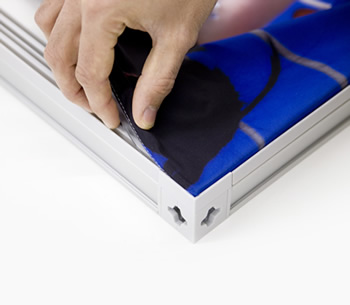As the textile printing eco story strengthens, are you becoming more convinced it’s an option for your business?
We all recognise becoming 100% green is something is a long shot – but if we focus on some of the smaller elements such as eco-inks, emission free substrates and reducing waste we can take steps towards that. And that’s where textiles and soft signage can come in. The new generation of dye-sublimation systems are more sustainable than many of their fellow UV or eco solvent printers. By using dye-sub or latex inks on polyester substrates we can produce relatively green products.
With many wide-format print specialists looking for new, profitable markets, soft signage and textile production are a good prospect given an increasing demand for tactile marketing tools - flags, banners, POS displays and exhibition backdrops are all becoming ever more popular in fabric form and they deliver on multiple levels with, arguably, the strongest green credentials of any printed medium.
As we know, suppliers of dye-sublimation printers have focused their research and development on ecological textile production and are providing machines with lower energy consumption, no VOC’s and less drying time. Higher speeds are made possible by using the latest printheads. Degassing modules prevent nozzles from getting blocked by gasses or bubbles in the ink. The specially developed inks for colour sublimation printing dry quickly and offer top quality results. To improve print stability the latest machines are equipped with mist removal filters to counteract problems and can run unattended allowing for continual printing.
The bottom line is that the latest equipment on the market today is designed to support the eco story and improve productivity in the textile printing markets. So what is going to take the textile and soft signage printer into the next phase and beyond?
Mike Horsten, general marketing manager, EMEA says: “With the huge technological advances in the wide-format sector over the last five years I believe we will see double and triple growth in this sector in the next three years. One of the key moves will be in the management of the process. Workflow and automation will have to come on board to match the faster machines we are seeing on the market. This will be the ‘game changer’ and move this sector onwards and upwards.”
Horsten continues: “Investing in textile printing right now is a winner. It’s a wide-open space offering exceptional added-value opportunities to the market. This is an optimum business proposition. There is a huge drive in the retail sector with companies looking to maximize the impact of environmental influences on business. Dye-sublimation can provide a perfect solution here as it is easy to transport, simple to manufacture and ultimately environmentally friendly using recyclable water-based inks. As the retail sector is responsible for 60% of all graphics, the combination of these factors makes this an ideal solution. “
Soyang Europe’s sales manager Tim Egerton is also well placed to comment. “Direct to textile printed retail graphics on pre-coated polyester offer vibrant and durable colours due to the aqueous inks used in the process. These inks are also more eco-friendly than their solvent counterparts. Whilst polyester can be printed directly, using the transfer method is ideal for uncoated substrates and those that exhibit stretch, such as poly-lycra blends used for tensioned drums seen in exhibition halls.
“The big eco benefit of direct printing to a coated fabric is that it cuts out a process. An alternative to dye-sub inks is to print directly to textile using either UV or latex inks which do not require post print processing. What this means to the non-specialist printer is that if they’re already running a wide-format latex or UV cure machine, they can make the simple transition to an alternative substrate and use the same machine and inks to create a whole new area of business. Having a range of textiles that work for these different inks can result in a company getting more use out of existing hardware and reducing the environmental impact of additional machinery.”


